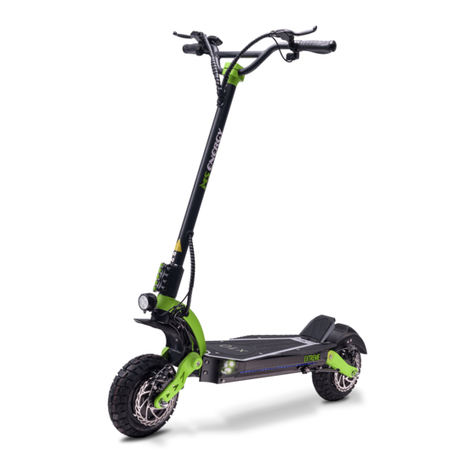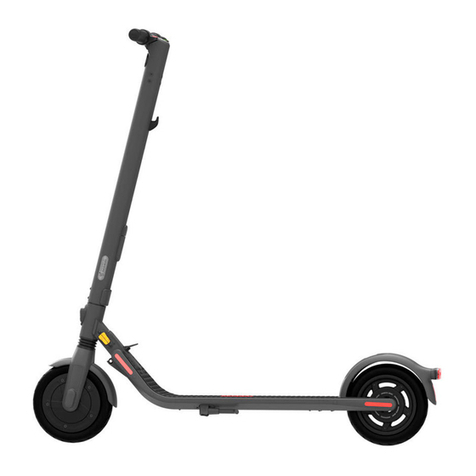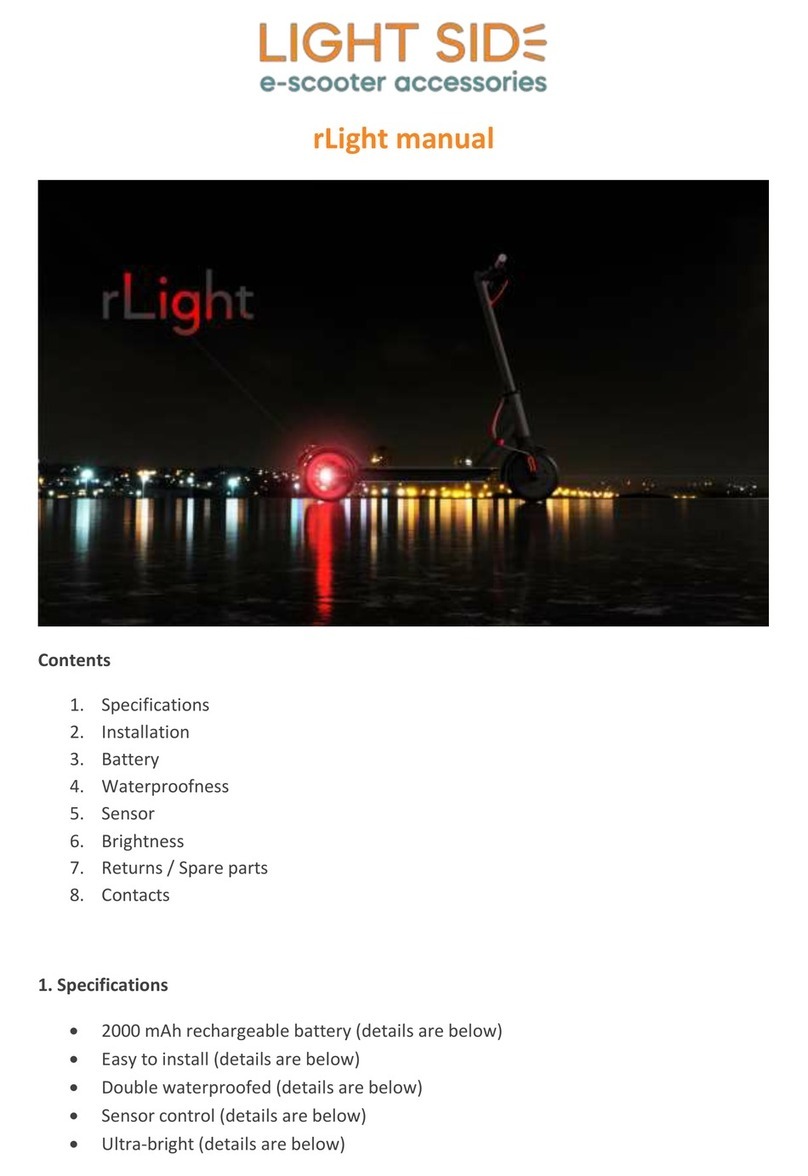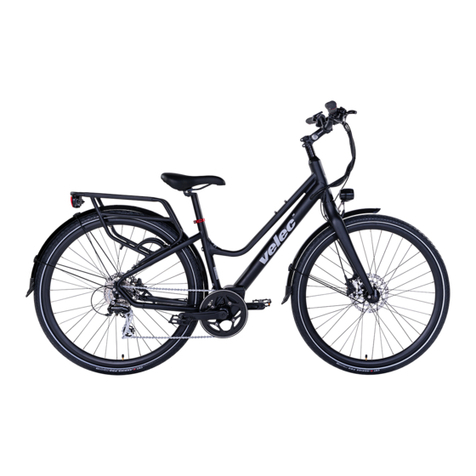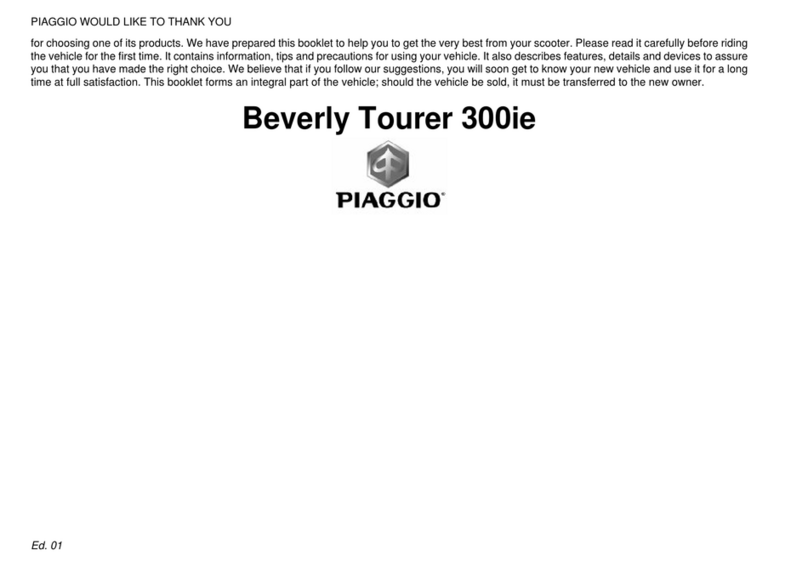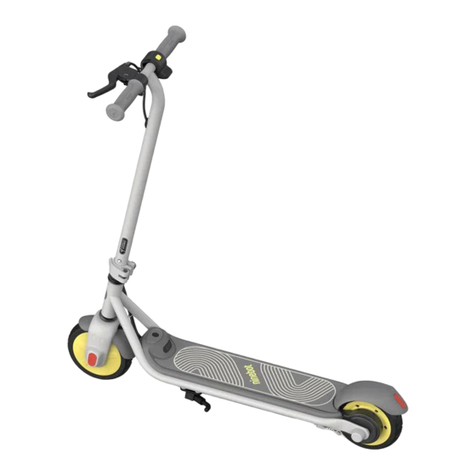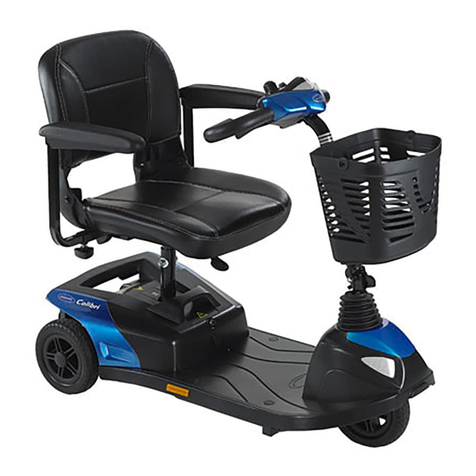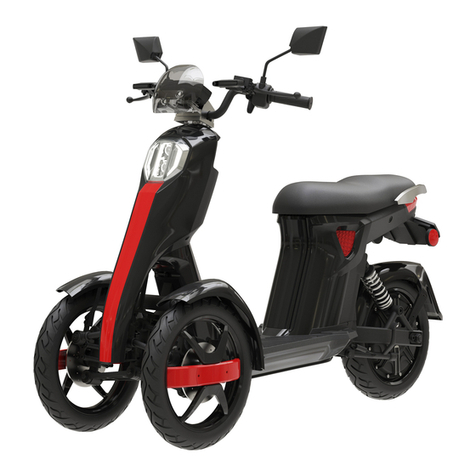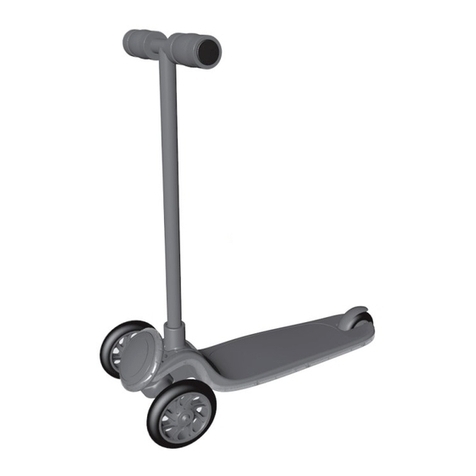Nipponia BRIO 125-3 User manual

Owner’s manual
BRIO 125-3
Nipponia S.A.

1
INTRODUCTION
This Owner’s Manual contains basic instructions on how to operate, inspect and maintain your
motorcycle. Please read it carefully and thoroughly. Correctly operating, maintaining and repairing your
motorcycle will minimise any possible risks and result in its best performance. The authorised Nipponia
service points will be glad to provide you with more detailed instructions.
Important information contained in this manual is marked using the following symbols:
NOTE: Important information or instructions
! ATTENTION: Important information or instructions. Failure to follow these instructions may result
in damage to your motorcycle or minor injury
! WARNING: Important information or instructions. Failure to follow these instructions may result
in heavy damage to your motorcycle, serious injury or even death
This manual is an integral part of the motorcycle and must always accompany it, even in the event of a
resale.
If you have any questions concerning the contents of this manual or need further information regarding
the operation of your motorcycle, do not hesitate to contact your local Nipponia dealer.
This booklet is compiled with the latest available information. However, due to constant improvements,
modifications or alterations may be made without prior notification. Updated versions can be
downloaded from the Nipponia website www.nipponia.com.

2
CONTENTS
Introduction 1
Contents 2
Safety Information 4
Safe riding 4
Protective clothing 5
Vehicle modifications 5
Loading 5
Accessories 6
Warning labels 6
Vehicle Identification 7
Vehicle Description 8
Left view 8
Right view 9
Instruments and controls 10
Main Components 11
Instrument panel 11
Speedometer 11
Fuel gauge 11
Tachometer 11
High beam light 11
Right turning signal indicator 11
Gear display 11
Left turning signal indicator 11
EFI trouble indicator 11
Odometer 12
Controls 12
Main/Ignition switch 12
Steering lock 13
Anti-theft switch 13
Start button 14
Dimmer switch 14
Turn signal switch 14
Horn button 14
Seat 15
Storage compartment 15
Helmet hook 16
Fuel Tank 16
Fuel 16
Fuel valve 17
Driving Instructions 18
Pre-operation Inspection 18
Starting the Engine 19
Start button / Kick starting 20

3
CONTENTS
Driving 21
Braking 22
Parking 23
Engine Break-in 24
Gear shifting 25
Service and Maintenance 26
Maintenance Schedule 26
Engine oil 27
Engine oil level inspection 27
Engine oil replacement 28
Air Cleaner 29
Spark Plug 30
Spark plug inspection and replacement 30
Tyres 31
Brakes 32
Brake fluid inspection 32
Front brake inspection 33
Rear brake inspection 34
Wear condition of the brakes 35
Battery 35
Battery removal 36
Electric fuse 37
Clutch 37
Drive chain 38
Drive chain inspection 38
Drive chain adjustment 39
Drive chain lubrication 39
Adjustment of the rear brake light 40
Throttle grip 40
Care and Storage Guide 41
Long-term storage 41
Cleaning 42
EFI Using Instruction 43
System parts description 43
ECU 43
Fuel pump assy 43
Throttle valve assembly 43
Oxygen sensor 44
Temperature sensors 44
Service and maintenance 45
Troubleshooting and counteractions 47
Diagnostic system instructions 48
Specifications 50
Service Schedule 51

4
SAFETY INFORMATION
Safe riding
1. Always perform the pre-operation inspection before driving.
2. The motorcycle should not be used by anyone who does not hold a valid driving license.
3. Many accidents involve motorcycles not seen by other drivers, so please pay attention to the following:
•Wear bright-coloured clothes.
•Do not drive too close to other vehicles or in another driver’s blind spot.
•Avoid overtaking.
4. Always follow local traffic regulations.
•Driving above the speed limit is the reason for many accidents. Driving speed must not exceed the
limit specified by traffic regulations and allowed by road conditions.
•Always signal when turning or changing lanes in order to attract the attention of the other drivers.
5. Never drive under the influence of alcohol or other drugs; it dramatically increases the risk of accidents.
6. Exercise special attention when driving over crossroads or parking area exits.
7. When driving you must hold the handlebars with both hands and place your feet on the driver steps.
The passenger should hold the handgrips or the driver and place his feet on the pillion steps.
8. This motorcycle is designed for on-road use only. It is not suitable for off-road use.

5
SAFETY INFORMATION
Protective clothing
1. For your safety, the driver and passenger should both wear helmets. Use of additional safety apparel
(gloves, glasses, protective wear) is recommended.
2. Do not wear loose clothing, as it may be caught by the handle levers, the kick starter or the wheels and
could lead to an accident.
3. During or after operation, the muffler’s temperature is very high. Exercise extreme caution as it can
cause burns.
Vehicle modifications
Making any modifications to the motorcycle or replacing the original components can affect its
performance and safety and/or render it illegal for use. Observe applicable laws and all national and local
regulations concerning vehicle equipment. Additionally, such modifications will cancel the warranty.
Loading
Adding accessories or cargo to your motorcycle can adversely affect stability and handling if the weight
distribution of the motorcycle is changed. Use extra care when riding a motorcycle with extra load. Here
are some general guidelines to follow when loading cargo or adding accessories to your motorcycle:
1. All accessories must be fastened securely on the vehicle in order to minimise vibration that could cause
instability.
2. Any extra load should be placed as close to the gravity centre as possible and must be equally

6
SAFETY INFORMATION
distributed on both sides of the motorcycle to avoid imbalance and instability.
3. The tyre pressure must be adapted to the weight of the load and road conditions.
4. Make sure that extra load is securely attached to the vehicle to prevent it from falling and being lost.
5. Do not hang any load on the handlebars or the suspension.
6. The total weight of the driver, passenger, accessories and cargo must not exceed the maximum load
limit of the motorcycle (160kg).
Accessories
When installing accessories not approved by Nipponia, attention should be paid to the following points:
1. The installation of the accessories must not affect the suspension travel, the light position and the
steering angle.
2. Do not obstruct the ventilation duct, to ensure adequate cooling of the engine.
3. Avoid installing any accessories that could hinder your access to vehicle controls and movement of your
hands and feet as it could impair your reaction in an emergency event.
4. Do not install a bulb with higher power than that specified. It could burn the fuse or cause problems to
the electrical system due to low voltage.
5. Do not add a sidecar to the motorcycle.
Warning labels
The warning labels are sited on your vehicle. They contain particularly important information for both
your safety and the optimum performance of your scooter. Information on the vehicle’s tyres is also
provided (see pg. 31 of this manual).

7
VEHICLE IDENTIFICATION
The Engine number (3) is engraved on the left lower part of the engine case. The Frame label (1) is located
on the middle tube of the frame, under the seat. The Vehicle identification number-VIN (2) is located on
the rear bar of the motorcycle frame, under the seat.
You can write your motorcycle’s identification numbers here:
Vehicle identification number: …………………………………………………………………
Engine number: …………………………………………………………………………..……………
NOTE:
-Please make a note of your motorcycle’s VIN and Engine number, so you can place your orders quickly when
purchasing spare parts from Nipponia.

8
VEHICLE DESCRIPTION
Left view
1: Gearshift, 2: Left driver footstep, 3: Main stand, 4: Side stand, 5: Left pillion step,
6: Seat lock, 7: Helmet hook

9
VEHICLE DESCRIPTION
Right view
1: Kick starter arm, 2: Rear brake pedal, 3: Foot step, 4: Right pillion step,
5: Exhaust muffler

10
VEHICLE DESCRIPTION
Instruments and controls
1: Instrument panel, 2: Throttle grip, 3: Front brake lever, 4: Start button, 5: Ignition switch,
6: Horn button, 7: Turn signal switch, 8: Dimmer switch

11
MAIN COMPONENTS
Instrument Panel
Speedometer (1)
This meter displays the current driving speed in km/h and mph.
Fuel gauge (2)
This gauge indicates the amount of fuel left in the fuel tank. When the
hand reaches the F (Full) mark, there are 3.5L in the tank. When it
reaches the red area, there is about 1L left in the tank and it needs to
be refilled.
Tachometer (3)
This meter displays the current rotation speed of the engine in rpm.
High Beam light (4)
This indicator lights when the dimmer switch is in the high beam position.
Right turning signal indicator (5)
This indicator flashes when right turn signal light is on.
Gear display (6)
It indicates the number of the current position of the gear.
Left turning signal indicator (7)
This indicator flashes when left turn signal light is on.

12
MAIN COMPONENTS
EFI trouble indicator (8)
When the engine starts, the indicator lights for 3 seconds.
Odometer (9)
This meter displays the accumulated mileage of the motorcycle in km.
Controls
Main/Ignition switch (1)
The main switch is located at the upper right part of the frame
body. It is used to control the ignition and electrical systems,
and to lock the steering wheel. To use it insert the ignition key.
The switch can then be turned to the following positions:
“ ” ON: The engine and the electrical system are on and the key
cannot be removed.
“ ”OFF: The engine and the electrical system are off, and the key can
be removed.
“ ”Steering lock: The steering is locked and cannot be turned, the
engine and the electrical system are off and the key can be removed.

13
MAIN COMPONENTS
Steering lock
To lock the steering, turn the handlebars all the way to the left and insert the key in the main switch (1).
Then press down and, while pressing, turn to “ ” position to lock. To unlock the steering, insert the key
and turn it to “ ” position.
To prevent from theft, always lock the steering when parked.
Anti-theft switch (2)
The anti-theft switch is located under the ignition switch. It isolates the ignition circuit and protects your
motorcycle from theft.
To activate the anti-theft switch first remove the ignition key from the ignition switch and use the special
key of the anti-theft switch (at the top side of the ignition key). Then turn the special key clockwise to the
“SHUT” position. The ignition circuit has been cut-off. Turn the special key counter-clockwise to the
“OPEN”position when you want to start the ignition switch.
NOTE:
- When locking the steering, the handlebars must be turned to full left position and the key should be pressed
properly.
- After locking the steering, move the handlebars slightly to check whether they have locked.
!WARNING:
- Never turn the key to “ ” or to “ ” position while driving as it may cause an accident.

14
MAIN COMPONENTS
Right handlebar switches
Start button (1)
To start the engine, using the starting button, make sure that you shift the gear
to neutral and you raise the side stand. Press the start button to start the
engine.
Left handlebar switches
Dimmer switch (1)
This switch controls the headlight beam (with the light switch in “ ”position).
Turn signal switch (2)
Push and hold this switch to “ ” position to signal a left-hand turn or to
“ ” position to signal a right-hand turn. The switch returns to the centre
position automatically.
Horn button (3)
Press this button to sound the horn.
“ ”: High beam
“”: Low beam

15
MAIN COMPONENTS
Seat
To open the seat, first unlock it from the seat lock (at the left side) turning the key clockwise and then lift
it up.
To close the seat, lower it down and push the rear part of the seat until you hear a clicking sound. This
indicates that the seat is locked. Then you can remove the key from the lock.
Always make sure that the seat is securely locked before driving.
Storage compartment
The storage compartment is located under the seat. Its maximum loading capacity is 5kg.
NOTE:
-Be careful while washing your motorcycle, as the storage compartment may get wet.
-Do not keep valuable items in the storage compartment.
!WARNING:
-You should not exceed the maximum loading weight (5kg) of the storage compartment, as it may affect the
control and stability of your motorcycle.
-As the storage compartment is near the engine, which can reach high temperatures, avoid storing any low heat-
resistant or flammable items.

16
MAIN COMPONENTS
Helmet hook
Your motorcycle is provided with two helmet hooks (one for the driver and
one for the pillion passenger). To hang your helmet, first open the seat, hang
the helmet on the hook (1), close and lock the seat.
To unhang your helmet, open the seat, take the helmet off the hook and lock
the seat.
Fuel Tank
The fuel tank is located under the seat. To refuel lift the seat and turn the fuel tank
cap (1) counter-clockwise to open it. After refuelling make sure to close the fuel tank
tightly by turning the fuel tank cap clockwise.
Fuel
Use only 90-97 octane unleaded gasoline.
!WARNING:
- You can use the hook only after you park your vehicle.
- Do not leave your helmet on the hook when you are driving.
1: Fuel tank cap
1: Helmet hook

17
MAIN COMPONENTS
Fuel valve
A ball-type valve is located at the left side of the carburettor. It controls or
blocks the flow of the gasoline.
Turn the handle to position (1) in order to release the gasoline flow.
Turn the valve handle to position (2) in order to block the gasoline flow. It is
recommended for long term storage.
!WARNING:
-When refuelling, be careful not to spill any gasoline out of the tank. After refuelling, please check around the
fuel tank for any gasoline and make sure it is dry before starting the engine.
-Avoiding breathing any gasoline vapours.
-Keep away from children.
!WARNING:
- Gasoline is highly flammable and may be explosive. Always turn off the engine before refuelling.
-Never smoke while refuelling and avoid sparks, flames or any other source that could ignite the fuel.
-Do not overfill the tank. After refuelling, always make sure that the cap is securely closed.

18
DRIVING INSTRUCTIONS
Pre-operation Inspection
Always perform the pre-operation inspection, before driving your motorcycle. Failure to do so may result
in vehicle damage or an accident.
The time required to perform the necessary inspection is very short. However, it both ensures your safe
driving and, in the long term, saves you time from vehicle repairs.
Make sure to inspect the following items:
Item
Inspection
Fuel
- Check the fuel level and refuel if necessary
- Inspect the fuel circuit for any fuel leakage
Engine oil
- Check the engine oil and refill to the specified level if necessary
- Inspect the motorcycle for any oil leakage
Front and rear
brakes
- Check operation of the brakes
- Inspect condition of the brake pads
- Check the brake fluids and refill to the specified level if necessary
- Inspect the hydraulic system for any leakage
Wheels and tyres
- Check tyre condition and tyre wear
- Check for any potential damage to the wheels or tyres
- Inspect the air pressure and adjust if necessary

19
DRIVING INSTRUCTIONS
Item
Inspection
Drive chain
- Check condition of the drive chain
- Check lubrication of the drive chain and lubricate if necessary
Throttle grip
- Check operation of the throttle grip. It should be able to turn smoothly and be
fully opened and closed
- Inspect condition and free play of the cable
Brake levers
- Check whether the brake levers operate smoothly and lubricate the joints if
necessary
Lights and
instruments
- Inspect operation of the headlight, rear light, brake light, turn signal lights, horn
and panel instruments
If you need assistance on how to perform any of the above-mentioned tasks, do not hesitate to contact
an authorised Nipponia service point.
Starting the Engine
Before starting the engine make sure to raise the side stand. You can rest the motorcycle on the main
stand. To start the engine, use A or B starting mode:
!WARNING:
-If any item in the pre-operation inspection list is not functioning properly, have it inspected and repaired before
operating the motorcycle.
Table of contents
Other Nipponia Scooter manuals

Nipponia
Nipponia Volty User manual
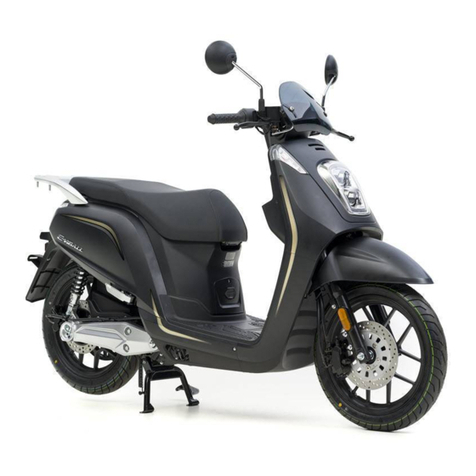
Nipponia
Nipponia E-Viball 1S Instruction manual
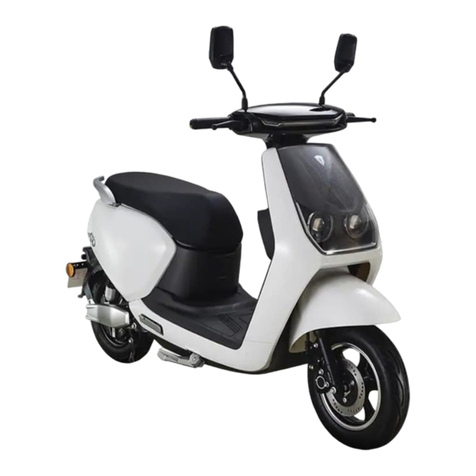
Nipponia
Nipponia Cit-e User manual
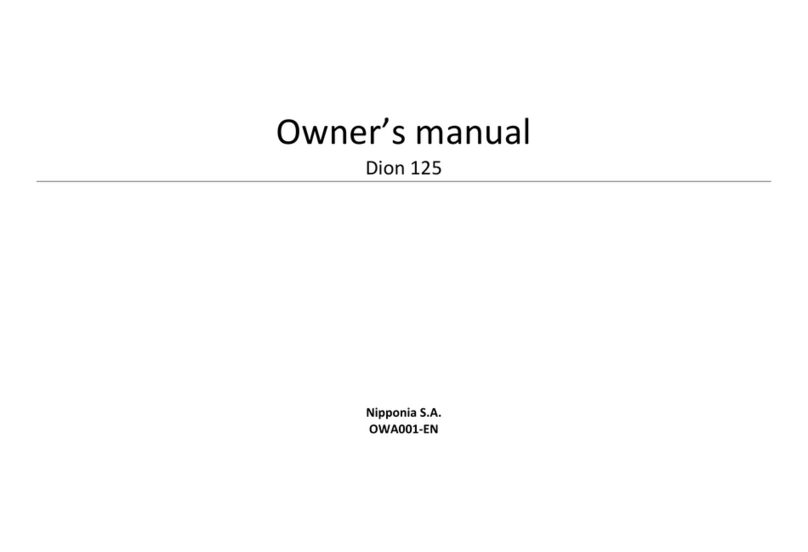
Nipponia
Nipponia Dion 125 User manual
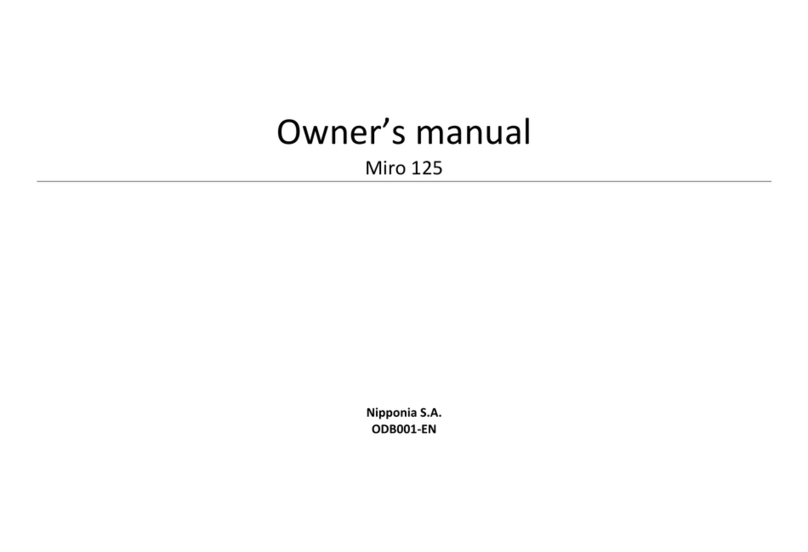
Nipponia
Nipponia Miro 125 User manual
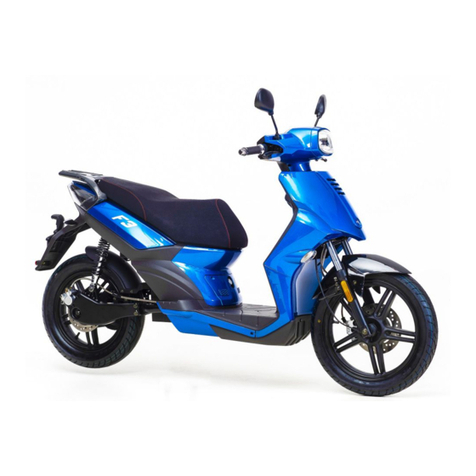
Nipponia
Nipponia F3 User manual
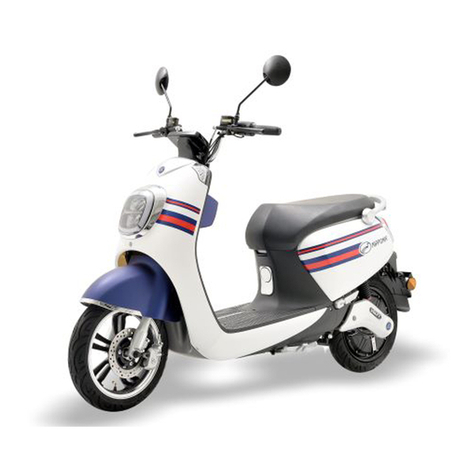
Nipponia
Nipponia Volty Instruction manual
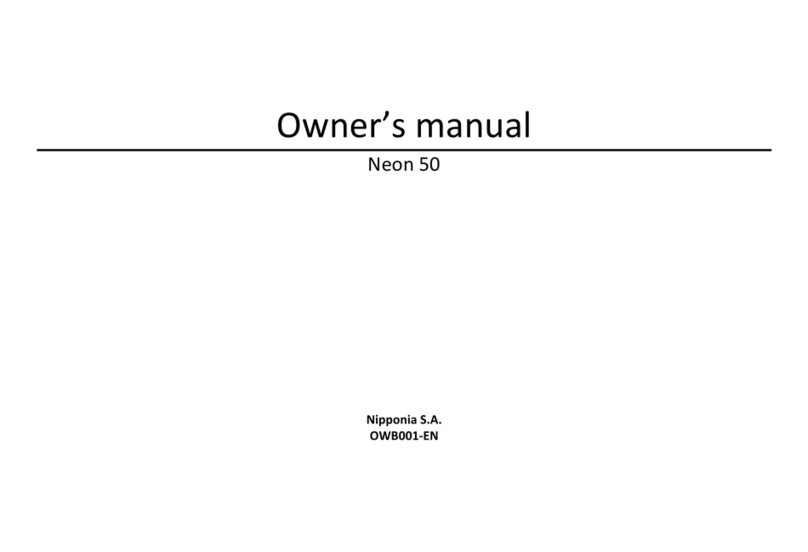
Nipponia
Nipponia Neon User manual
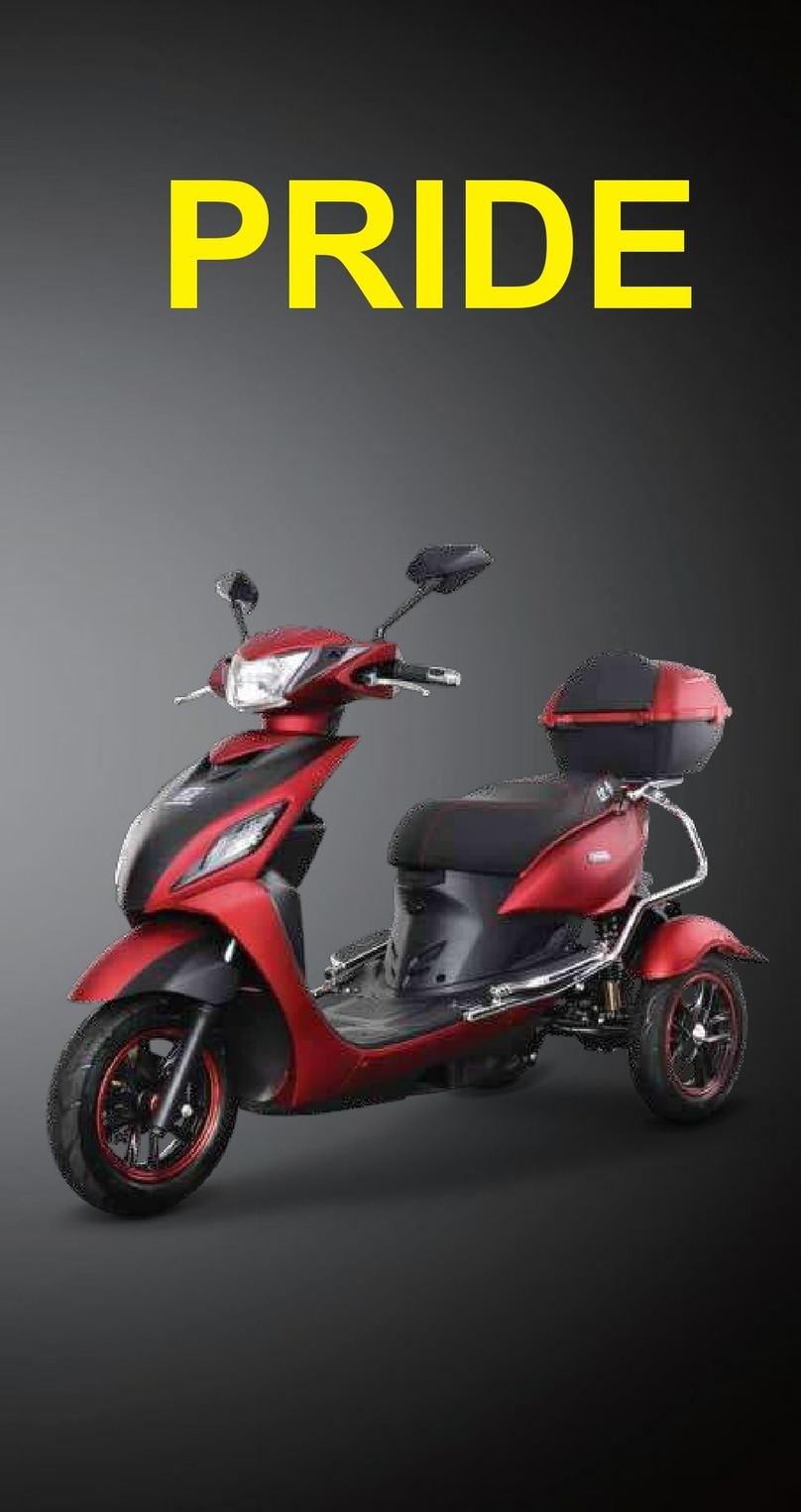
Nipponia
Nipponia PRIDE User manual
